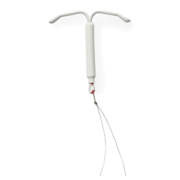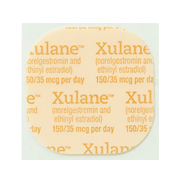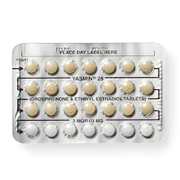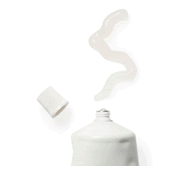Birth control on the horizon: 2016 edition
In which we squint into the distance and report on everything we see over yonder.

We love to roll out the red carpet when a new method of birth control becomes available. We’ve also been known to get excited about birth control innovations that are still in the works. Here’s what we see on the horizon from where we’re standing in 2016.
Rings that work for a year
Right now there’s only one ring on the market—the NuvaRing—and it needs to be replaced every month. But two new vaginal rings in development could change that. Both are designed to work for a whole year by storing a larger amount of hormone and releasing it slowly. (We’re betting that since the rings carry more hormones, they’re thicker than the NuvaRing.) The companies developing the rings have been pretty hush-hush, but we can give you a few details.
A progestin-only vaginal ring. The maker of the Yasmin pill and the Mirena IUD, Bayer, is working on a one-year vaginal ring that releases the hormone levonorgestrel. Levonorgestrel (LNG) is one of the oldest, safest, and best-studied hormones out there. The new ring releases about 40 micrograms of LNG per day, which is less than one-tenth of the daily dose in a progestin-only pill. It looks like the study is testing how effective this ring is when it’s kept in place continuously.
An extended version of the NuvaRing. The same company that makes the NuvaRing, Merck, is working on a one-year vaginal ring that releases two hormones, estrogen and a progestin called etonogestrel. These are the same hormones found in NuvaRing, just released over the course of a year instead of a month. Merck is testing keeping the ring in for 3 weeks, taking it out for a week, then putting it in again. It might be that women who prefer to skip periods could use this ring continuously, but they’re not testing that in this study.
A new minipill
There are only a few types of progestin-only pills (commonly known as “minipills”) available in the U.S., and all contain a progestin called norethindrone. Now a French company, Leon Pharma, is testing a progestin-only pill with drospirenone. That’s the same hormone found in the combined hormonal pills YAZ and Yasmin. Like other progestin-only pills, this one is designed to be used for 24 days followed by a 4-day break. Researchers did a similar study in Europe, and found that over 80% of women were satisfied with this minipill.
If you’re thinking “I want this method now!”
If any of these methods make your heart flutter, you may qualify to participate in the studies about them. This online service provides information about all kinds of clinical trials—including birth control trials—and connects you to any studies in your area. Another source of information is ClinicalTrials.gov, which tells you right up top whether studies are looking for new participants.
A lower-dose patch
A company called Agile is working on a new contraceptive patch called Twirla. Like the only patch currently on the market, Xulane, a single Twirla patch is designed to last one week. You use three patches, then take a week off. Here’s how Twirla and Xulane are different:
Both patches release two hormones, estrogen and progestin, but they use different kinds of progestin. Xulane releases the progestin norelgestromin, while Twirla releases levonorgestrel.
Twirla releases about half the amount of estrogen Xulane does (30 versus 56 micrograms per day).
Twirla has a different adhesive from Xulane, designed to prevent the skin around the patch from feeling sticky.
A new spermicide
The only spermicides currently approved by the Food and Drug Administration (FDA) contain nonoxynol-9, but that may change soon. A women’s health company called Evofem has a new spermicide based on lactic and citric acids, called Amphora. They tested its effectiveness as a method of birth control, and found that it was about the same as other spermicides. Now the FDA is reviewing the evidence, and could approve it for sale in the U.S. any day. Next up, Evofem is testing Amphora as a treatment for recurrent bacterial vaginosis.
Further down the road…
All the methods above are in what’s called phase 3 clinical trials—that’s a large study that tracks safety and effectiveness of a new birth control method for at least a year. There are also methods that are in earlier stages of development, in phase 1 or 2 studies. It may be years before these methods are actually available, but we can dream about them in the meantime:
A new non-hormonal IUD called Veracept is made out of the same stuff as the “intrauterine ball” (copper beads on a memory metal frame), but it has a different shape. Although the ball turned out to be a bust, Veracept has good results so far.
A new hormonal IUD designed for teens is being tested in Europe. Although studies show that teens can safely use any of the IUDs now available in the U.S., this one is smaller and designed to last for less time than even a Skyla. There’s no word yet on when this might come to the U.S.
Yet another vaginal ring is in development, this one releasing estrogen and the progestin nesterone.
Various doses of the drug in the emergency contraceptive ella, ulipristal acetate, are being tested as a daily pill.
A new spermicide called Contragel is based on lactic acid. There’s a small study testing the safety of Contragel used in combination with the Caya diaphragm. FYI, Contragel and Cayagel are the same thing, just packaged differently.
A hormonal contraceptive gel for men that is applied to the skin like lotion. The gel delivers the progestin nesterone and testosterone.
Our red carpet is ready if and when these methods make it to market—and we’ll keep you posted on other new developments in the meantime.
How do you feel about this article?

Heat up your weekends with our best sex tips and so much more.




